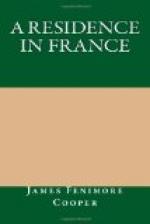We had made the acquaintance of a Flemish artist of extraordinary merit, at Paris; and this gentleman (Mr. Wappers) kindly called this morning to take us to see the gallery. The collection is not particularly large, nor is it rich in cabinet pictures, being chiefly composed of altar-pieces taken from churches. The works are principally those of Rubens, Vandyke, and a few of the older masters. The Vandykes, I think, are the best. On the whole, it struck me there were more curious than pleasing pictures in this gallery, although they are all valuable as belonging to a school. The study of the “Descent from the Cross” is among them, and it gave me more pleasure than anything else. Vandyke certainly rose in our estimation, after this close comparison with his great rival: he is altogether more human than Rubens, who is a sort of Dutch giant in the art; out of the natural proportions, and always a giant.
Mr. Wappers permitted us to see his own painting-room. He is of the school of the great Flemish masters, and, I think, quite at the head of his profession, in many of its leading points. It was curious to trace in the works of this young artist the effects of having Rubens and Vandyke constantly before him, corrected by the suggestions of his own genius. His style is something between the two; broader and bolder than Vandyke, and less robust than Rubens.
We went the round of the churches, for, if Italy be the land of marbles, Belgium is, or rather has been, the very paradise of those who carved in wood. I have seen more delicate and highly-finished works of this sort, in a small way, in other countries; as in the high reliefs of Santa Maria della Salute, at Venice; but nowhere else is so much attempted, or, indeed, so much achieved in this branch of art, as here. Many of the churches are quite surrounded by oak confessionals that are highly and allegorically ornamented; though, in general, the pulpits contain the most elaborate designs, and the greatest efforts of this curious work. One at Brussels has the Conversion of St. Paul, horse, rider and all, larger than life. The whole is well wrought, even to the expression. But the best specimens of carving in wood that I remember, were a few figures over the door of an hospital that we saw in 1828, though I now forget whether it was at Gorcum or at Breda. One often sees statuary of great pretension and a wide-spread reputation, that is wanting in the nature, simplicity, and repose of these figures.
We went to see a collection of pictures owned by Mr. Van Lankeren. It is a very fine gallery, but there are few paintings by very great artists. A Van der Heyden (an old New York name, by the way), surpassed anything I know, in its atmosphere. Poussin, and our own artist Cole, excel in this high merit, but this picture of Van der Heyden has a cold, gray transparency that seems actually to have transferred a Dutch atmosphere to the canvass.
We returned to Brussels in time to dine. At Malines I stood with admiration beneath the great tower, which possesses a rare majesty. Had it been completed according to the original plan, I believe it would have been the highest church-tower in Europe. In the evening we had a call from Mr. and Mrs. ——, and made an appointment to visit the palace of the Prince of Orange in the morning.




